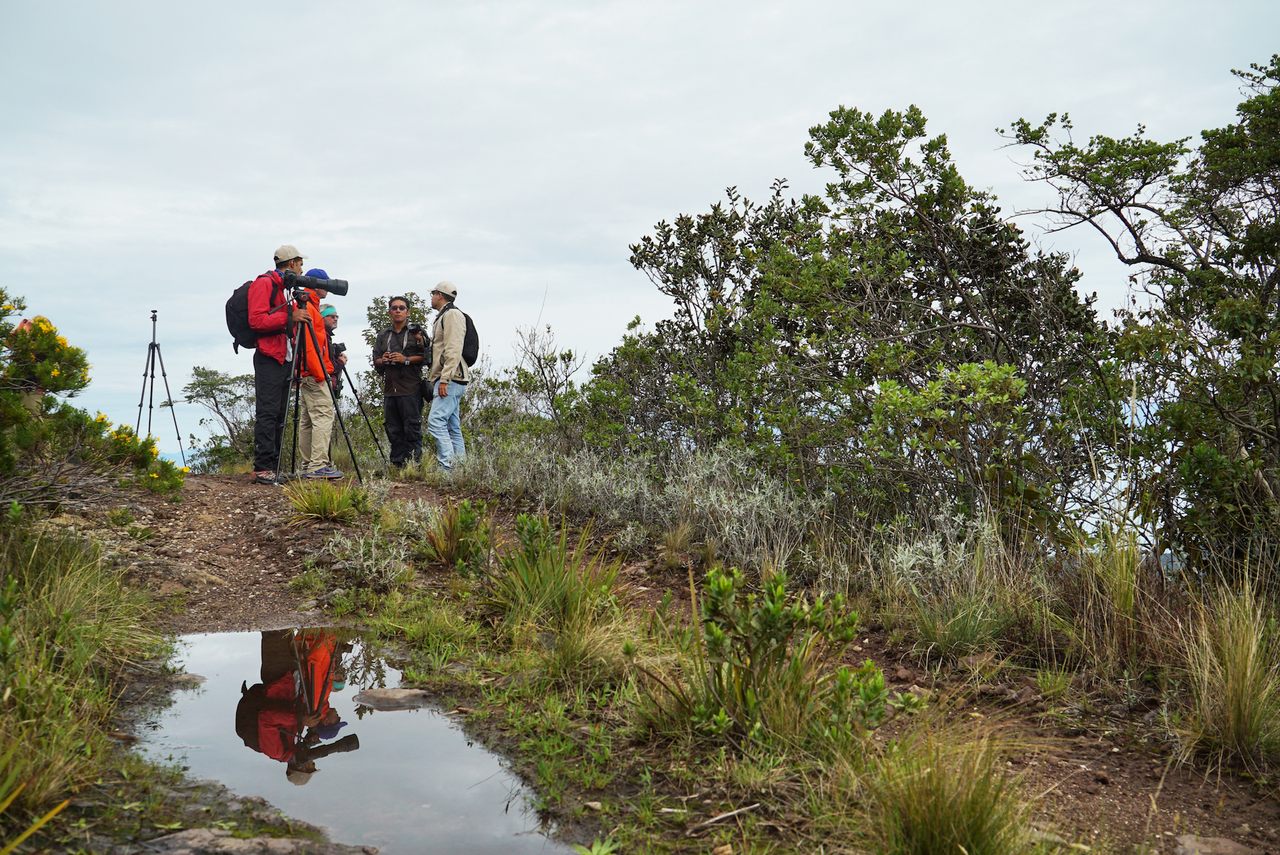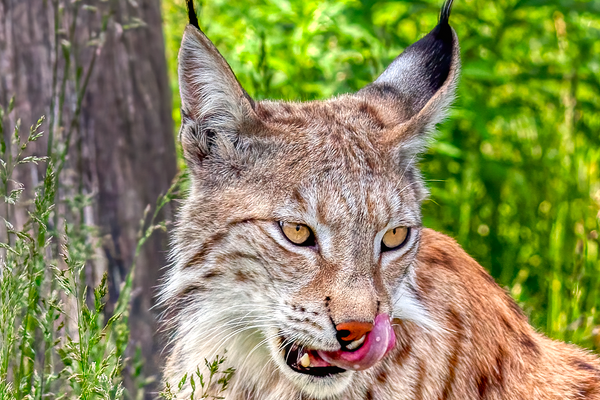In Search of Rare Birds and Glory in Colombia
How an international birdwatching competition draws attention to the country’s at-risk natural bounty.
Three hefty duffel bags packed with boots, waterproof clothing, and binoculars are slung into the back of a 4x4. Although it’s a hot, humid day in Valledupar, a small city in the Cesar municipality of northeastern Colombia, the temperature can drop to 30 degrees Fahrenheit in the mountains.
The group, consisting of two Colombians and an American, is headed for Serranía del Perijá, the mountain range that looms over the city, and separates the country from Venezuela. They’re making the nearly three-hour pilgrimage in preparation for the following day: May 5, 2018, or Global Big Day, the Olympics of birdwatching.
The Serranía del Perijá is home to three species of birds that do not live anywhere else in the world: the Perijá metaltail, Perijá thistletail, and the Perijá tapaculo. But it’s only recently that birders have been able to access the mountain range, a side effect of Colombia’s 2016 peace deal, which was signed between the Colombian government and the guerrilla group Revolutionary Armed Forces of Colombia (FARC), following a 50-year-long conflict.
But these previously inaccessible outlying regions now face an uncertain future. In 2016, as The Guardian reports, deforestation increased by 44 percent, as illegal logging and mining took their toll. The publication also notes that farmers, known as campesinos, were once required by the FARC to keep 20 percent of their land forested, but no longer abide by that policy. Nearly 98 percent of Colombia’s tropical mountain forests have been destroyed, meaning all three of the aforementioned birds are considered endangered species, making them even harder to spot.

An international birding competition, Global Big Day was started in 2015 by Cornell University’s Ornithology Lab in a two-pronged attempt to gather data on bird species across the globe and boost the profile of birdwatching. Anyone can participate in the event and upload their lists of the birds they’ve spotted onto an international database called e-bird. Birdwatchers have 24 hours to tick off as many species as possible, either by eye or by ear. Then they have a few days—this year, until May 8—to upload their lists.
Peru won the title of most species sighted for the first two years, but last year, Colombia toppled the reigning champions to take the crown. And rightly so.

The South American country has more than 1,900 species of birds, around 20 percent of the bird species in the world, with 10 percent native to Northern Colombia. The exact number is still contested, partially because more studies are required on subspecies to decide whether they should be counted as individual species, and also because the conflict affected scientists’ ability to study birds in remote areas. In 2016, Colombia’s birders registered 949 species and placed third, while in 2017, the country spotted 1,486 species, beating Peru’s 1,331 total.
“Colombia should have won the first two years, considering the country has the most species of bird in the world,” explains John Myers, an American living in the country and working with Conservation International. Myers organized this expedition to Serranía del Perijá in a bid to ensure Colombia retained its title this year. “It was only last year that the country could mobilize and fully participate in the day, not to mention that we can now access places previously out of bounds which contain rare and endemic species of birds.”
For Myers and his group, spotting the Perijá metaltail, Perijá thistletail, and the Perijá tapaculo in the 24-hour window will not only help the tally climb, but holds added significance, as the birds cannot be found anywhere else in Colombia.
“So no pressure then,” jokes Myers.

The mountain range, which rises above 11,910 feet, marks the northern end of South America’s Andes, the longest continental mountain range in the world. Recent studies in the region discovered the Perijá tapaculo, as well as registering four hundred bird species and finding three endemic bird species that are endangered due to a loss of habitat.
The range is one of the least explored regions in the Northern Andes, and for visiting scientists and ornithologists, the excitement of discovering a new species is very real. “It’s a really exciting time for researchers, as we can now access these areas that we haven’t been able to study for decades,” Myers says. “Thanks to the peace deal, these remote areas are finally opening up to birders and environmentalists.”
Myers has assembled a small but skilled team for the task. Jose Luis Ropero, a 32-year-old former student of Myers’s, has lived in Valledupar all his life and taken numerous trips to Serranía del Perijá.* Likened to characters on The Big Bang Theory, he’s soft-spoken and has an extensive knowledge of ornithology, despite only picking up binoculars in 2015. A well-thumbed Field Guide to the Birds of Colombia (2nd Edition) never leaves his side, permanently nestled in the knapsack slung across his shoulder. “It’s like my Bible,” he says, patting the 380-page book proudly. Ropero says he learned English so he could read it.
On Global Big Day, Ropero hopes to catch sight of the swallow tanager, his favorite bird and the mascot of the ecological foundation he set up in 2012. Dazzling blue in color, it sports a white underbelly and a black mask across its eyes.
Jorge Arango, nicknamed “Jota,” which is the Spanish pronunciation of the letter “J,” is the last member of the triumvirate. He’s a skilled nature photographer from Medellín and is accompanying the group with his Nikon and 600mm lens.

“Most people in this town probably don’t even know why you’re all here,” sighs Don Thomas Guttiérez, a Valledupar resident who dropped by to speak to the trio before they left on their birding journey. Although there is a devout network of birders in country, Guttiérez explains there is still an ignorance when it comes to biodiversity and environment in Colombia.
It’s perhaps unsurprising. Colombia, home to more than 48 million people, is only just emerging from a 50-year-long civil war, which saw the FARC and National Liberation Army (ELN) guerrilla groups, paramilitaries, and the government army pitted against each other, plus the added interventions from narco traffickers, who had their own agenda.
The internationally lauded, but internally divisive, peace agreement was finally signed in 2016, and saw the FARC demobilize, moving out of vast swathes of the country, particularly mountainous regions such as the Serranía del Perijá.
“Older generations can’t fathom why anyone would want to run around in the mountains looking for birds,” says Myers. “For them, the mountains are synonymous with danger.”
But it is to the mountains the group is headed, loading up a 4x4 and waving farewell to Guttiérez.

The road to Manaure, a small town located at the base of the Perijá mountains, is surprisingly smooth. The flat, humid plains of Valledupar soon give way to the thick, cool shrubs of the foothills. But soon, the smooth road turns to no road at all, just a single-track lane zig-zagging through the mountainside. It’s a bone-rattling, nearly three-hour journey to the Chamicero del Perijá reserve, owned by conservation charity Fundación ProAves, where the trio will bunk down for the night in order to be in position for the competition.
Halfway up the mountain, the 4x4 meets a small truck, loaded with timber. It’s an uncomfortably tight squeeze and the 4x4 gets stuck, its wheels spinning furiously, churning up dark red mud and belching a cloud of exhaust fumes. Arango jumps out to push and after a few minutes of engine revving, the car skids out of the ditch, sliding heart-stoppingly close to the edge of the mountain, where a sheer drop awaits. The driver wrenches the steering wheel to the right and cruises back to the middle of the road, where Arango hops in.
In the car, Myers announced that the group will be joined by Oswaldo Cortes, who he describes as “one of Colombia’s best birders,” and it’s clear it’s an honor to have him along for the trip.

It’s another hour before Myers spots the reserve, perched precariously on the mountain opposite, a splash of white amongst the dense green. By the time the group arrives, the sun is going down over the Sierra Nevada de Santa Marta mountains in the distance, setting the sky aglow in a fiery orange, bathing the valley below in a warm red. Hummingbirds zip around the trees in front of the reserve, feasting on nectar. The reserve’s visitors watch the scene in muted awe as the sun finally sets and the call for dinner is sounded.
Over their meal, the group, now joined by Cortes and two American tourists, Jim Sandor and Toni Kimple, discusses the plan for Global Big Day. It’s too early to get excited: Weather could severely dampen the chances of sighting the three birds on the hit list.
Sandor, from California, is on a mission to see 120 new species during his three-week trip along the Northern Colombia Birding Trail, which, coincidentally, Myers had a hand in designing while he worked for Audubon Society. Sandor, who’s already clocked up more than 1,700, wants to hit 2,400 bird species in his lifetime, and Kimple jokes he doesn’t have long left. It’s the second time the pair, both in their late 70s, has visited Colombia.

It’s now nearly 9 p.m., and the generators are due to turn off, leaving the reserve in complete darkness. The residents turn in, ready for an early morning start.
The next morning, over a breakfast of arepa, huevos pericos, chocolate caliente, and a lashing of coffee, the excitement is palpable. Cortes, who sighted 241 birds on last year’s Global Big Day, has already been up since 3 a.m., and clocked 25 birds. The weather is good and the group is in high spirits.
The first stop of the day is nearly 10,000 feet up on the mountain known as Cerro Pintado, home to one of Colombia’s páramos—a unique treeless ecosystem found high up in the country’s mountains—and the three birds the team needs to spot. “It won’t be easy, but we’re with the best person we can be with to make this happen,” says Myers. “Oswaldo knows every spot, every hiding place.”
It’s the first time Myers has spent the Global Big Day in Serranía del Perijá, and he’s aiming to spot 75 birds, despite racking up 131 sightings last year during a visit to Los Llanos, an area to the east of the Andes.
“It’s harder to spot birds up here—the higher you climb, the more scarce they get,” Myers explains. “But the ones you do see are very special. The tapaculo will be a pain in the rear to find, as it skulks around in coarse shrubbery.” Nevertheless, he’s pumped and positive for the day. “It’s really important we spot these birds, because no other group is up here. If we don’t catch sight of them, no one else will.”

After another jolting journey to the top of the mountain, the group disembarks from the vehicle. There’s a lengthy period of hushed silence, as the members of the group peer expectantly through binoculars and creep around the undergrowth. Cortes plays the call of the pygmy owl, a predator, in order to coax the birds out of hiding.
“We don’t think it’s good to play it too many times though,” he adds. “We don’t want to scare off the birds. So we also play their call to them to see if they will answer.”
And sure enough, after almost an hour of patiently scanning the trees, the group has ticked off both the Perijá metaltail, a beautiful species of hummingbird with a long beak, startlingly-bright green plume, orange and olive-speckled breast, and garnet red tail; and the Perijá thistletail, a brown bird with a long, ragged tail, grey breast, and flecks of ochre under its chin.
Now the one bird left on the must-see list is the tapaculo, and so the group hits the single-track lane again to head further down the mountain. It’s a couple of hours until Cortes signals for the 4x4 to stop and leaps out. He strides ahead and crouches down, peering into a dense bush. The group crowds around as he plays the call of the tapaculo. Minutes pass. Finally, someone points excitedly and six pairs of binoculars train their sights onto the coarse shrub. There’s a small, almost unnoticeable movement. It’s the tapaculo, a peculiar looking egg-shaped bird, reddish brown in color with spindly legs.
Myers double fist-pumps in jubilation. Now the group can relax, and take their time tallying up other species. For the rest of the day, the count slowly rises: 31 after spotting the Perijá brush finch, another rare bird; 36 after spotting the black-crested warbler, a “lifer” (the term for the first time an individual sees a bird species) for Myers; and 38 after Ropero spots a lifer of his own, the rufous antpitta.

A little after 5 p.m., there’s one last coup. Ropero spots the swallow tanager. He smiles and studiously takes out his notebook from his back pocket, scribbling the name down on his list, taking the total count to 46.
Of the 1,900-odd species Colombia boasts, to date more than 75 percent were spotted on May 5, providing scientists with data that would otherwise have taken months, if not years, to collect. In total, 1,548 species were spotted, meaning that Colombia is once again the world leader for Global Big Day.
“This is a poster child of the potential of citizen science,” says Myers. “But there’s still one question remaining: Where is the other 25 percent? Is it just a logistical issue of getting out and registering these birds? If we submitted 30,000 lists, like the U.S. does, would we register all the birds? Or are the birds even still alive?”
Due to the inaccessibility and remoteness of vast areas in Colombia, including the Serranía del Perijá, events such as the Global Big Day are invaluable to scientists. Not only does registering bird species provide scientists with valuable data, it acts as ammunition in the argument to protect Colombia’s ecosystems from further deforestation and destruction.
*Correction: This article originally stated that Jose Luis Ropero’s last name was “Rospero.”

























Follow us on Twitter to get the latest on the world's hidden wonders.
Like us on Facebook to get the latest on the world's hidden wonders.
Follow us on Twitter Like us on Facebook